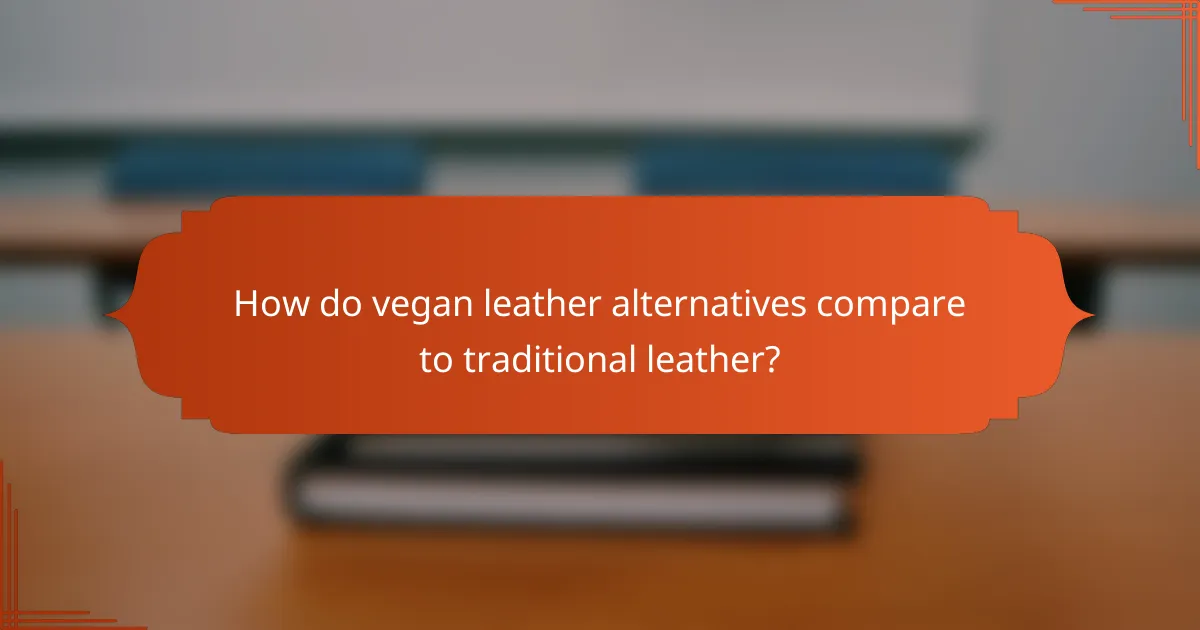Vegan leather alternatives provide a sustainable and ethical choice for consumers looking to reduce their environmental impact while avoiding animal products. Materials such as pleather, pineapple leather, and mushroom leather each come with unique benefits, making them appealing for various styles and uses. By opting for these alternatives, individuals can support animal welfare and contribute to a more eco-friendly fashion industry.

What are the best vegan leather alternatives available?
The best vegan leather alternatives include materials like pleather, pineapple leather, mushroom leather, cork leather, and recycled plastic leather. Each of these options offers unique benefits and considerations for consumers seeking sustainable and ethical choices.
Pleather (Polyurethane)
Pleather, or polyurethane leather, is a synthetic material designed to mimic the look and feel of real leather. It is often more affordable than traditional leather and can be produced in various textures and colors.
However, pleather is made from petroleum-based products, which raises concerns about environmental impact. When choosing pleather, look for options that are free from harmful chemicals and produced with eco-friendly processes.
Pineapple leather (Piñatex)
Pineapple leather, known as Piñatex, is made from the fibers of pineapple leaves, a byproduct of the fruit industry. This innovative material is biodegradable and offers a unique texture, making it a popular choice for fashion accessories and apparel.
While Piñatex is sustainable, it may not be as durable as traditional leather. It’s essential to consider the intended use and care requirements when selecting products made from pineapple leather.
Mushroom leather (Mylo)
Mushroom leather, branded as Mylo, is crafted from mycelium, the root structure of mushrooms. This material is biodegradable and can be produced with minimal environmental impact, making it an appealing option for eco-conscious consumers.
Mylo offers a soft texture and can be dyed in various colors. However, availability may be limited, and consumers should check for brands that prioritize sustainable sourcing and production practices.
Cork leather
Cork leather is made from the bark of cork oak trees, which can be harvested without harming the tree. This renewable resource is lightweight, water-resistant, and has a unique appearance, making it suitable for various products.
While cork leather is durable, it may not have the same luxurious feel as traditional leather. It’s a great option for those looking for a sustainable alternative with a distinct aesthetic.
Recycled plastic leather
Recycled plastic leather is created from post-consumer plastic waste, such as bottles and bags, which are processed into a leather-like material. This option helps reduce plastic pollution while providing a viable alternative to traditional leather.
When selecting recycled plastic leather, look for products that emphasize transparency in their sourcing and manufacturing processes. This ensures that the environmental benefits are maximized and that the product is safe for use.

What are the benefits of using vegan leather alternatives?
Vegan leather alternatives offer several advantages, including environmental sustainability, improved animal welfare, and a wide variety of styles. These materials often require fewer resources to produce and can reduce the demand for animal-based products.
Environmental sustainability
Vegan leather alternatives are generally more environmentally friendly than traditional leather. Many options, such as those made from recycled plastics or plant-based materials, have a lower carbon footprint and use less water during production.
For instance, materials like cork or pineapple leaves (Piñatex) are renewable and biodegradable, making them appealing choices for eco-conscious consumers. Choosing these alternatives can contribute to reducing waste and pollution.
Animal welfare
Using vegan leather alternatives directly supports animal welfare by eliminating the need for animal skins. This shift helps reduce the suffering associated with the livestock industry, where animals are often subjected to harsh conditions.
By opting for synthetic or plant-based materials, consumers can align their purchasing decisions with ethical considerations, promoting a more compassionate approach to fashion and accessories.
Durability and maintenance
Many vegan leather alternatives are designed to be durable and easy to maintain. For example, high-quality synthetic leathers can be resistant to wear and tear, making them suitable for everyday use.
Maintenance typically involves simple cleaning with a damp cloth, unlike traditional leather, which may require special conditioners and treatments. This ease of care can be a significant advantage for busy individuals.
Variety of styles
The market for vegan leather alternatives has expanded significantly, offering a wide range of styles, colors, and textures. Consumers can find everything from sleek handbags to stylish jackets, all made from innovative materials.
This variety allows individuals to express their personal style without compromising their values. With options available at various price points, there is likely a vegan leather product to suit every taste and budget.

How do vegan leather alternatives compare to traditional leather?
Vegan leather alternatives generally offer a more sustainable and animal-friendly option compared to traditional leather. While they can vary significantly in terms of cost, durability, and production methods, many consumers find them appealing for ethical and environmental reasons.
Cost comparison
The cost of vegan leather alternatives can vary widely, often ranging from affordable to premium pricing. For instance, synthetic options like polyurethane (PU) can be less expensive than traditional leather, typically costing between $20 to $100 per yard, while high-quality plant-based leathers may reach similar or higher price points as genuine leather.
When budgeting for vegan leather, consider not only the initial purchase price but also potential long-term savings in maintenance and care. Traditional leather often requires more upkeep, which can add to its overall cost over time.
Longevity and wear
Vegan leather alternatives typically have varying degrees of durability. While some synthetic options can be quite resilient, they may not match the lifespan of high-quality traditional leather, which can last for years or even decades with proper care. Plant-based leathers, on the other hand, often provide a balance between durability and environmental impact.
It’s essential to assess the intended use of the material. For items subject to heavy wear, such as shoes or bags, choosing a high-quality vegan leather may be crucial to ensure longevity.
Production processes
The production processes for vegan leather alternatives differ significantly from traditional leather, which involves animal hides and often harsh chemical treatments. Many vegan leathers are made from synthetic materials like PVC or PU, while others utilize natural sources such as pineapple leaves, apple peels, or cork.
When evaluating vegan leather options, consider the environmental impact of the production methods. Some materials may be more sustainable than others, so look for certifications or transparency from manufacturers regarding their practices. This can help ensure that your choice aligns with ethical and ecological values.

What ethical considerations should be taken into account?
When choosing vegan leather alternatives, several ethical considerations are crucial. These include labor practices in production and the impact on local ecosystems, both of which can significantly influence the overall sustainability and ethical footprint of these materials.
Labor practices in production
Labor practices in the production of vegan leather can vary widely, affecting workers’ rights and conditions. It’s essential to consider whether the materials are sourced from companies that adhere to fair labor standards, such as paying living wages and ensuring safe working environments.
Look for certifications like Fair Trade or similar labels that indicate ethical labor practices. Avoid brands that do not provide transparency about their supply chains, as this can often signal potential exploitation or unsafe working conditions.
Impact on local ecosystems
The production of vegan leather can have varying impacts on local ecosystems, depending on the materials used. For instance, some synthetic alternatives may rely on petroleum-based products, which can contribute to pollution and habitat destruction during extraction and manufacturing processes.
On the other hand, plant-based options, such as those made from pineapple leaves or apple peels, can offer more sustainable choices. However, it’s important to assess the agricultural practices involved, as intensive farming can lead to biodiversity loss and soil degradation. Supporting brands that prioritize sustainable sourcing and eco-friendly practices can help mitigate these impacts.

What are the market trends for vegan leather alternatives in the USA?
The market for vegan leather alternatives in the USA is rapidly expanding, driven by increasing consumer awareness and demand for sustainable products. This trend reflects a broader shift towards ethical consumption, with many brands adopting plant-based materials to meet customer preferences.
Growing consumer demand
Consumer interest in vegan leather alternatives has surged, with many shoppers actively seeking out cruelty-free and environmentally friendly options. Surveys indicate that a significant portion of the population is willing to pay a premium for products made from sustainable materials, often prioritizing brands that align with their values.
This growing demand is influencing major retailers and fashion brands to incorporate vegan leather into their product lines, resulting in a wider variety of styles and options available to consumers. As awareness of the environmental impact of traditional leather production increases, this trend is expected to continue.
Innovations in material technology
Advancements in material technology are playing a crucial role in the development of vegan leather alternatives. Innovations include the use of materials derived from plants, such as pineapple leaves, apple peels, and mushrooms, which offer durability and aesthetic appeal similar to traditional leather.
These new materials not only reduce reliance on petroleum-based products but also often have a lower environmental footprint. Brands are increasingly experimenting with these technologies to create high-quality, stylish alternatives that appeal to eco-conscious consumers.

What future developments can we expect in vegan leather alternatives?
Future developments in vegan leather alternatives are likely to focus on innovative materials and broader brand adoption. As technology advances, we can expect more sustainable options that meet consumer demand for ethical and environmentally friendly products.
Emerging sustainable materials
New materials are continuously being developed to replace traditional leather, with a focus on sustainability. Options like mushroom leather, made from mycelium, and pineapple leather, derived from the fibers of pineapple leaves, are gaining traction. These materials not only reduce reliance on animal products but also minimize environmental impact.
Additionally, lab-grown leather is emerging as a viable alternative, offering the look and feel of animal leather without the ethical concerns. These innovations often utilize less water and energy compared to conventional leather production, making them more eco-friendly choices.
Increased brand adoption
More brands are recognizing the importance of vegan leather alternatives and are incorporating them into their product lines. This shift is driven by consumer demand for ethical fashion and sustainability. Major fashion labels are now launching collections that feature vegan materials, signaling a significant trend in the industry.
As awareness grows, smaller brands are also entering the market with innovative vegan leather products, often at competitive prices. This increased adoption not only broadens consumer choices but also encourages more sustainable practices across the fashion sector.
